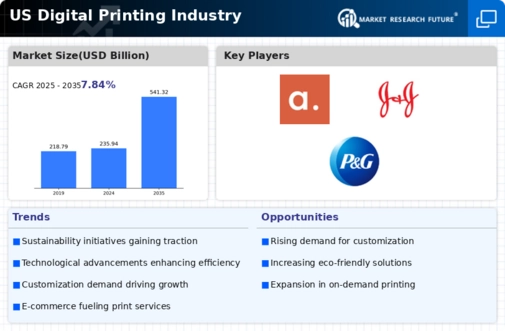Rising Demand for Short-Run Printing
The digital printing market experiences a notable increase in demand for short-run printing solutions. Businesses are increasingly seeking to produce smaller quantities of printed materials, which aligns with the flexibility offered by digital printing technologies. This trend is particularly evident in sectors such as marketing and advertising, where rapid turnaround times are essential. According to recent data, the short-run printing segment is projected to grow at a CAGR of approximately 8% over the next five years. This growth is driven by the need for customized marketing materials and the ability to quickly adapt to changing consumer preferences. As a result, the digital printing market is well-positioned to capitalize on this shift, providing tailored solutions that meet the evolving needs of businesses.
Growth of E-commerce and Online Retail
The digital printing market is significantly influenced by the growth of e-commerce and online retail. As more businesses establish an online presence, the demand for printed materials such as packaging, labels, and promotional items increases. E-commerce companies often require customized solutions to enhance their branding and customer experience. This trend is expected to drive the digital printing market, with projections indicating a potential increase in demand for packaging solutions by over 10% annually. The ability to produce high-quality, visually appealing prints on demand aligns well with the needs of online retailers, making digital printing an essential component of their marketing strategies.
Environmental Regulations and Compliance
The digital printing market is increasingly impacted by environmental regulations and compliance requirements. As sustainability becomes a priority for consumers and businesses alike, companies are seeking eco-friendly printing solutions. This shift is prompting digital printing providers to adopt sustainable practices, such as using recyclable materials and eco-friendly inks. Compliance with environmental regulations not only enhances a company's reputation but also opens up new market opportunities. As of November 2025, the demand for sustainable printing solutions is projected to grow by approximately 12% annually. This trend indicates that the digital printing market is evolving to meet the expectations of environmentally conscious consumers, thereby driving innovation and growth in sustainable printing practices.
Increased Focus on Branding and Marketing
In the competitive landscape of modern business, companies are placing a heightened emphasis on branding and marketing efforts. The digital printing market is benefiting from this trend as businesses seek innovative ways to differentiate themselves. Custom printed materials, such as brochures, business cards, and promotional items, are essential tools for effective branding. As organizations strive to create memorable customer experiences, the demand for high-quality printed materials is expected to rise. Market analysis suggests that spending on marketing materials is likely to increase by approximately 15% over the next few years, further propelling the growth of the digital printing market. This focus on branding underscores the importance of digital printing in helping businesses convey their unique identities.
Advancements in Digital Printing Technology
Technological advancements play a crucial role in shaping the digital printing market. Innovations such as high-speed inkjet printing and improved color management systems enhance the quality and efficiency of printed materials. These advancements enable businesses to produce high-quality prints at lower costs, thereby attracting a wider customer base. The introduction of new substrates and inks further expands the capabilities of digital printing, allowing for a diverse range of applications. As of November 2025, the market for digital printing technology is expected to reach approximately $25 billion, reflecting a robust growth trajectory. The digital printing market is likely to benefit from ongoing research and development efforts aimed at enhancing printing capabilities and reducing production times.













Leave a Comment